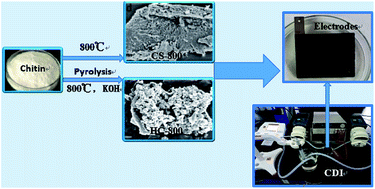Chitin derived biochar for efficient capacitive deionization performance
Abstract
The selection and preparation of an electrode material is the core of capacitive deionization. In order to obtain a material with a good deionization properties, we have designed an environmentally-friendly and simple way of preparing biochar. In this work, biochar was prepared by a thermal-deposition method and after chemical modification it was characterized with a scanning electron microscope (SEM), Fourier transform infrared spectrophotometer (FTIR), X-ray diffraction (XRD) and X-ray photoelectron spectroscopy (XPS). The specific surface area of biochar modified by KOH is as high as 833.76 m2 g−1, but the specific surface area of the unmodified electrode material is only 126.43 m2 g−1. The electrochemical analysis (CV and EIS) of the biochar indicates that HC-800 has a lower charge transfer resistance and a higher specific capacitance, where the specific capacity of HC-800 reaches 120 F g−1. A CDI property analysis of HC-800 shows a better electrosorption capacity of 11.52 mg g−1 and better regeneration and cycling stability than CS-800. The desalination amount remains 87.23% after several cycles.



 Please wait while we load your content...
Please wait while we load your content...